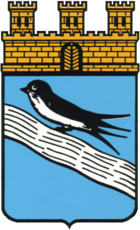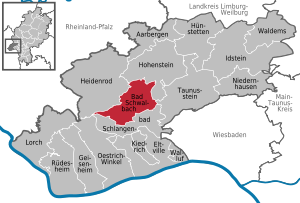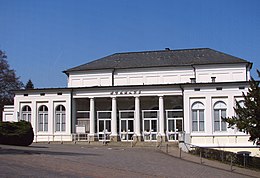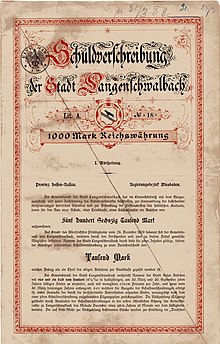Bad Schwalbach
| coat of arms | Germany map | |
|---|---|---|

|
Coordinates: 50 ° 8 ' N , 8 ° 4' E |
|
| Basic data | ||
| State : | Hesse | |
| Administrative region : | Darmstadt | |
| County : | Rheingau-Taunus district | |
| Height : | 306 m above sea level NHN | |
| Area : | 40.27 km 2 | |
| Residents: | 11,191 (Dec. 31, 2019) | |
| Population density : | 278 inhabitants per km 2 | |
| Postal code : | 65307 | |
| Area code : | 06124 | |
| License plate : | RÜD, SWA | |
| Community key : | 06 4 39 002 | |
| LOCODE : | DE SHW | |
| NUTS : | DE71D | |
| City structure: | Core city and 7 districts | |
City administration address : |
Adolfstrasse 38 65307 Bad Schwalbach |
|
| Website : | ||
| Mayor : | Markus Oberndörfer ( SPD ) | |
| Location of the city of Bad Schwalbach in the Rheingau-Taunus district | ||

Bad Schwalbach (until April 21, 1927 Langenschwalbach ) is the district town in the Rheingau-Taunus district in southern Hesse . The city is one of the oldest Hessian therapeutic baths , at the same time it has been a recognized Kneipp health resort since 2014 .
geography
Geographical location
Bad Schwalbach is a health resort about 20 kilometers northwest of the Hessian capital Wiesbaden . The core city is located 289 to 465 meters above sea level in the western Hintertaunus, very elongated 2.5 kilometers in length in a left side valley of the Aar through which the Nesselbach flows. Over 56 percent of the municipal area consists of forest.
Neighboring communities and districts
Bad Schwalbach borders in the north on the community Hohenstein , in the east on the city Taunusstein , in the south on the community Schlangenbad and in the west on the community Heidenrod .
City structure
The city consists of the districts Adolfseck , the core city Bad Schwalbach, Fischbach , Heimbach , Hettenhain , Langenseifen , Lindschied and Ramschied .
For the seven outside the core city Bad Schwalbach lying neighborhoods each one was local district formed. Each local district has a local council of seven members chaired by a local mayor .
history
- For the Roman past see also the main article Small fort Adolfseck .
Bad Schwalbach was first mentioned as Langinswalbach in 1352 and has been known as a parish since 1364. Other historically documented mentions of the place name are Swalbach 1360 and Langenschwalbach at the beginning of the 16th century. The first reliable reports about the mineral springs are from 1568 by the Worms doctor Tabernaemontanus , who also made the place known in his work Neuw Wasserschatz , published in 1581 . The Auxiliary Bishop of Speyer, Heinrich Fabricius , was already in 1583 for a cure at the Sauerbrunnen in Bad Schwalbach. Although Langenschwalbach was completely destroyed in the Thirty Years' War , it was quickly rebuilt and the medicinal water trade began to flourish. Initially, the water was sold by mail order in jugs and barrels across Europe. Only a few people seeking healing made the arduous journey into the Taunus.
In the Middle Ages, Langenschwalbach was one of the 15 elevated villages that belonged to Kurmainz . Over time, the County of Katzenelnbogen gained more and more influence on the places outside the Rheingau Gebück , which eventually became part of the Lower County of Katzenelnbogen and were subordinate to the Hohenstein Office . In 1729 Langenschwalbach became the seat of the Hohenstein Office, which however kept its name. After the French occupation of the Left Bank of the Rhine in 1794, the administration of the entire Lower County was relocated to Langenschwalbach. Since 1806 the Imperial Prefectural Council Balthasar Pietsch administered the territory of the Pays réservé de Catzenellenbogen from Langenschwalbach on behalf of Napoleon . When the Duchy of Nassau finally took possession of this area on October 17, 1816 , Langenschwalbach designated it as the seat of a ducal office .
It was not until the beginning of the 19th century that the health resort started operating with the improvement of traffic conditions through road construction. After Francis Head published Bubbles from the Brunnen in 1830 , the Taunus baths became popular among the British. Numerous crowned heads, princes and counts came to the cure and visited the casino, where less serious people frequented. During the upswing after the Nassau acquisition and the publication of the "Bubbles", Schlangenbad and Schwalbach had no location disadvantage compared to Bad Ems or Wiesbaden. With the construction of the Cursaal building until 1879 (today's spa house in a Renaissance-related style), the claim to improved spa conditions was taken into account. Parallel to the improvements in local facilities, traveling by stagecoach (until around 1845) became obsolete due to the faster, more comfortable and cheaper railroad. The Aartalbahn from Wiesbaden to Langenschwalbach, completed in 1889 , also contributed significantly to the upswing. After the end of the First World War , the popularity of the nobility as a spa clientele quickly lost its importance, and the lengthy change from a luxury spa to a spa open to the general public with an adaptation to other social conditions and demands began was completed after World War II .
In a forest near Langenschwalbach, Katharina Pfeiffer from Langenhain im Taunus is said to have given birth to a child to the robber Schinderhannes in late 1800 or early 1801 .
Lord Carnarvon had a serious accident in 1901 while driving a car on the Bäderstrasse and suffered from the consequences of the accident until the end of his life. For health reasons, he liked to stay in Egypt during the winter months and met Howard Carter , the co-discoverer of the royal tomb of Tut-Ench-Amun , whose excavations in the Valley of the Kings he financed from then on. Lord Carnarvon died on April 6, 1923.
Incorporations
At 31 December 1971 in the wake of were municipal reform in Hesse , the previously independent municipalities Adolfseck, Fischbach, Heimbach, Hettenhain, Langenseifen and Ramschied voluntarily incorporated . Lindschied was incorporated into the city on January 1, 1977 by virtue of state law. Local districts with local advisory councils and local councilors have been set up for all city districts .
politics
City Council
The local elections on March 6, 2016 produced the following results, compared to previous local elections:
| Parties and constituencies | % 2016 |
Seats 2016 |
% 2011 |
Seats 2011 |
% 2006 |
Seats 2006 |
% 2001 |
Seats 2001 |
||
|---|---|---|---|---|---|---|---|---|---|---|
| CDU | Christian Democratic Union of Germany | 31.6 | 12 | 26.5 | 10 | 34.1 | 13 | 33.0 | 12 | |
| SPD | Social Democratic Party of Germany | 20.8 | 8th | 24.5 | 9 | 30.8 | 11 | 32.8 | 12 | |
| Green | Alliance 90 / The Greens | 16.8 | 6th | 19.0 | 7th | 11.1 | 4th | 9.3 | 4th | |
| BLF | Bourgeois Liberal Group | 8.6 | 3 | - | - | - | - | - | - | |
| SWA & BSB | Our Bad Schwalbach & Bad Schwalbacher Bürgerblock |
22.2 | 8th | - | - | - | - | - | - | |
| SWA | SWA-Our Bad Schwalbach | - | - | 18.1 | 7th | - | - | - | - | |
| BSB | Bad Schwalbacher Citizens' Block | - | - | 7.9 | 3 | 15.8 | 6th | 11.2 | 4th | |
| FDP | Free Democratic Party | - | - | 4.2 | 1 | 4.0 | 1 | 3.9 | 1 | |
| FWG | Free voter community | - | - | - | - | 4.1 | 2 | 9.8 | 4th | |
| total | 100.0 | 37 | 100.0 | 37 | 100.0 | 37 | 100.0 | 37 | ||
| Voter turnout in% | 48.6 | 49.0 | 46.6 | 52.4 | ||||||
mayor
In the runoff election on November 24, 2019, Markus Oberndörfer (SDP) prevailed against Andreas Ruck (non-party) with 56.5 percent of the vote. The turnout was 42 percent.
Town twinning
An official city friendship has existed since 1993 with the commune of Buc , located near Versailles in the French region of Île-de-France .
Culture and sights
The Bad Schwalbacher Kurbahn , which runs on the historic tracks of the former Moortransportbahn in the Kurpark, offers special access to the town and spa history . From April to October the trains of the Bad Schwalbacher Kurbahnverein run on all Sundays and public holidays. From the Moorbadehaus station, the route leads to the moor pits, past the golf house, swallow fountain and forest lake.
From April 28, 2018 to October 7, 2018, the Hessian State Garden Show 2018 took place in Bad Schwalbach .
Bad Schwalbach's only museum, the “Kur · Stadt · Apothekenmuseum”, was opened in 2002 with new exhibits. With its exhibits, it guides visitors through the history of Bad Schwalbach and its spa life. The museum houses, among other things, the pharmacy museum, which used to be operated in private rooms. The pharmacy museum shows the oldest pharmacy in the Taunus, founded and fully equipped in 1642, the Adler pharmacy. The city archive is also housed in the museum.
The seven wells and many temples are also worth seeing. a. the Elisabethentempel, which was donated by the Empress Elisabeth of Austria-Hungary during a spa stay in Langenschwalbach. From there you have a good view of the city.
North of town is Alexander's Rest , a covered bench that serves as a memorial.
Religion and churches
- Kreuzkirche
- Martin Luther Church
- New Apostolic Church
- St. Elisabeth Church
Until 1938 there was also a synagogue in Bad Schwalbach , which was set on fire during the Reichspogromnacht .
Infrastructure and economy
Companies
The largest employer is the Schwälbchen dairy . The Klinikzentrum Lindenallee mbH is an interdisciplinary rehabilitation clinic and employs around 190 people. According to the spa status, Bad Schwalbach can refer to a number of other clinics, e.g. E.g. on the clinic at the park of the DRV Hessen, the Montanus clinic of the DRV Oldenburg-Bremen, the Otto-Fricke-Hospital Paulinenberg.
Authorities
The district court of Bad Schwalbach has its seat in the city. In addition to the city authorities, the employment agency, the tax office and the police have their local offices in Bad Schwalbach, the latter two in the authority center on Emser Straße.
fire Department
The fire brigade is in the hands of the volunteer fire brigade at two locations in Bad Schwalbach.
traffic
Bad Schwalbach is located on federal highway 260 , also known as Bäderstraße, as well as on the B 54 and B 275 . There is a motorway connection 15 kilometers away to the A 66 and 20 kilometers away at the Idstein junction of the A 3 .
The Bad Schwalbach station is located on the Aartalbahn on which no regular public transport are being operated since 1986th Bad Schwalbach is therefore one of the few German district towns that are no longer served by scheduled rail traffic. As a cultural monument, the route is Hesse’s longest architectural monument and is used seasonally at weekends by historic trains from the Nassau Tourist Railway . As part of the Wiesbaden Stadtbahn project, a resumption of passenger traffic between Bad Schwalbach and Wiesbaden was discussed between 1998 and 2001. Today there are plans to reactivate the Aartalbahn as a city or regional train. The Bad Schwalbacher Kurbahn is a narrow-gauge railway operated on weekends for excursion traffic from the mud bathing house to the moor pits.
school and education
- Nikolaus-August-Otto-Schule (cooperative comprehensive school with upper secondary school, approx. 1200 students)
- Wiedbachschule (primary school)
- Janusz Korczak School (School for Learning Assistance, Special Education Advisory and Support Center)
- International Opera Academy (vocational school for opera singers)
The Volkshochschule Bad Schwalbach has its local representative in Adolfstrasse. Bad Schwalbach can also refer to several kindergartens and day-care centers.
Personalities
In Bad Schwalbach were born:
- Polyxena of Hessen-Rotenburg-Rheinfels (1706–1735), Queen of Sardinia-Piedmont
- Ludolf von Langen (1803–1872), Nassau bailiff and member of parliament
- Edmund Heusinger von Waldegg (1817–1886), railway engineer
- Heinrich Maurer (1834–1918), Protestant clergyman
- Otto Frickhoeffer (1892–1968), composer and conductor
- Robert Philipp Nöll von der Nahmer (1899–1986), FDP politician
- Reinhard Suhren (1916–1984), frigate captain, submarine commander in World War II
- Benno Erhard (1923–2011), lawyer and politician (CDU)
- Bodo-Maria Erhard ISch (* 1924), physicist and Roman Catholic clergyman and superior general of the secular institute of the Schoenstatt Fathers (1968–1974)
- Hans-Klaus Jungheinrich (1938–2018), cultural journalist and author with a focus on music
- Jörg Fauser (1944–1987), journalist and writer
- Renate Kohn (* 1947), actress
- Harald Fuhr (* 1954), political scientist
- Peter Beck (* 1954), comedian and cabaret artist
- Michael Siebel (* 1957), SPD politician
- Stefan Rohrbacher (* 1958), Judaist and university professor
- Klaus-Peter Willsch (* 1961), CDU politician
- Christian Werner (* 1979), racing cyclist
- Erol Bulut (* 1975), football coach at Fenerbahce Istanbul
- Ayse Asar (* 1975), State Secretary in the Hessian Ministry for Science and Art
- Christian Stolz (* 1977), university professor
- Matthias Boosch (* 1982), writer
In addition, lived and worked in the community:
- Anton Mirou (1578 - around 1627), Flemish-Dutch painter, draftsman of the Schwalbacher Reise cycle
- Matthäus Merian the Elder (1593–1650), engraver and publisher, died in Bad Schwalbach
- Johann Heinrich Fenner von Fenneberg (1774–1849), spa doctor
- Philipp Hoffmann (1806–1889), architect and builder, builder of the Kurhaus . This was completely renovated by Helmut Hofmann in the 1960s
- Philipp Gosebruch (1835–1905), general practitioner, his monument is still in the spa gardens today
- Adolphus Busch (1839–1913), entrepreneur, died in Lindschied
- Paul Wallot (1841–1912), architect of the Reichstag building, died in Bad Schwalbach
- Friedrich Delitzsch (1850–1922), Assyriologist, also died here
- Julius Lippert (1895–1956), NSDAP politician, a. a. Lord Mayor of Berlin, died in Bad Schwalbach
- Bernhard Bendel (1908–1980), founder of the Catholic organization Opus Spiritus Sancti
The junior high school in the former Langenschwalbach (horseshoe school) visited in the years 1846 to 1848 Nikolaus Otto (1832-1891), who in the near an der Haide Holzhausen born co-inventor of the four-stroke principle, the honor since 1940, the gasoline engine bears his name.
literature
- David François Merveilleux, Pierre Joseph de LaPimpie Solignac: Amusemens des Eaux de Schwalbach, Or pastimes Bey the waters of Schwalbach, the baths of Wiesbaden, and the snake bath . Liège 1739 ( digitized ).
- Jörg Diefenbacher: The Schwalbach trip . Mannheim 2002, ISBN 3-00-008209-3 .
- Peter Bayerlein: Schinderhannes local dictionary . Mainz-Kostheim 2003.
- Gisela Ephan: Only memories remain ... Bad Schwalbach u. a. 2007, ISBN 3-85251-015-5 .
Web links
|
Further content in the sister projects of Wikipedia:
|
||
|
|
Commons | - multimedia content |
|
|
Wikisource | - Sources and full texts |
|
|
Wikivoyage | - Travel Guide |
- Bad Schwalbach, Rheingau-Taunus district. Historical local dictionary for Hessen. In: Landesgeschichtliches Informationssystem Hessen (LAGIS).
- Website of the Bad Schwalbach Museum
Individual evidence
- ↑ Hessian State Statistical Office: Population status on December 31, 2019 (districts and urban districts as well as municipalities, population figures based on the 2011 census) ( help ).
- ↑ 79th meeting of the specialist committee for health resorts, recreational areas and healing wells in Hesse on November 21, 2012 . In: State pointer for the state of Hesse . No. 9 , 2014, ISSN 0724-7885 , p. 187 .
- ↑ Local advisory boards in Bad Schwalbach ( Memento from July 18, 2011 in the Internet Archive )
- ^ "Bad Schwalbach, Rheingau-Taunus-Kreis". Historical local dictionary for Hesse (as of April 4, 2014). In: Landesgeschichtliches Informationssystem Hessen (LAGIS). Hessian State Office for Historical Cultural Studies (HLGL), accessed on June 23, 2014 .
- ^ Franz Xaver Remling: History of the Bishops of Speyer. Volume 2, p. 410
- ↑ Francis Head: Bubbles from the brunnen of Nassau ( 1866 edition )
- ↑ Henry Lohner: Only those who are dead do not take any more risks. Books on Demand, Norderstedt 2012, ISBN 978-3-8448-0977-0 , p. 87.
- ↑ Peter Bayerlein: Schinderhannes Ortlexikon. Wiesbaden 2013. p. 214
- ^ Federal Statistical Office (ed.): Historical municipality directory for the Federal Republic of Germany. Name, border and key number changes in municipalities, counties and administrative districts from May 27, 1970 to December 31, 1982 . W. Kohlhammer, Stuttgart / Mainz 1983, ISBN 3-17-003263-1 , p. 377 .
- ↑ Law on the reorganization of the Rheingau district and the Untertaunus district (GVBl. II 330-30) of June 26, 1974 . In: The Hessian Minister of the Interior (ed.): Law and Ordinance Gazette for the State of Hesse . 1974 No. 22 , p. 312 , § 1 ( online at the information system of the Hessian state parliament [PDF; 1.5 MB ]).
- ↑ main statute. (PDF; 85 kB) § 6. In: Website. City of Bad Schwalbach, accessed February 2019 .
- ^ Result of the municipal election on March 6, 2016. Hessian State Statistical Office, accessed in April 2016 .
- ^ Hessian State Statistical Office: Result of the municipal elections on March 27, 2011
- ^ Hessian State Statistical Office: Result of the municipal elections on March 26, 2006
- ↑ Mayoral election 2019 - runoff election. Retrieved June 17, 2020 .
- ^ The city friendship with Buc / France ( Memento from March 14, 2014 in the Internet Archive )
- ↑ Eckart Roloff and Karin Henke-Wendt: Small but nice - the oldest pharmacy in the Taunus. (Kur-Stadt-Apothekenmuseum, Bad Schwalbach) In: Visit your doctor or pharmacist. A tour through Germany's museums for medicine and pharmacy. Volume 2, Southern Germany. Verlag S. Hirzel, Stuttgart 2015, pp. 174-176, ISBN 978-3-7776-2511-9















